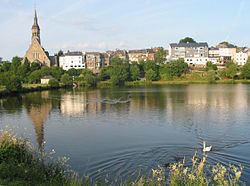Area codes 080 Local time Monday 6:29 AM Area code 080 | Postal codes 6690, 6692, 6698 Website vielsalm.be | |
 | ||
Weather 3°C, Wind N at 5 km/h, 98% Humidity Points of interest Baraque de Fraiture, The Baraque de Fraiture, Salm, Musée du Coticule, De Torens Van Het Kasteel V | ||
Vielsalm (Walloon: Li Viye Såm) is a Walloon municipality of Belgium located in the province of Luxembourg. The town is part of the Arrondissement of Bastogne. It is the place of origin of the House of Salm.
Contents
- Map of Vielsalm Belgium
- Etymology
- Geography
- History
- Economy
- Culture
- Sights
- Governance
- Education
- Notable residents
- Twinning
- References
Map of Vielsalm, Belgium
On 1 January 2007 the municipality had 7,339 inhabitants. The total area is 139.76 km2, giving a population density of 52.5 inhabitants per km2.
Etymology
The village, like Salmchâteau, takes its name from the River Salm. The region is also called the Val de Salm, and Salm region. The word "Salm" comes from the Celtic salwa, meaning black or blurred. Vielsalm means literally "Old Salm" because, at some point, the Lord moved his castle which became the new town centre.
A different popular etymology says Salm and Vielsam are taken from the German Salm, meaning salmon. The arms of the ancient house of Salm and those of the town are based on this interpretation.
Geography
Vielsalm is located in the Ardennes mountain range and the highest point within the municipal boundary is the Baraque de Fraiture, 652 metres (2,139 ft) high and is the third highest peak of Belgium. The town is surrounded by forests and farmland. In the centre is a large lake.
The municipality consists of the following sub-municipalities: Vielsalm proper, Bihain, Grand-Halleux, and Petit-Thier. Other population centers include Commanster, Fraiture, Farnières, Hébronval, Ottré, Provèdroux, Jubiéval, Règné, Rencheux, Ville-du-Bois, Petit-Halleux and Salmchâteau.
The town is situated between two main motorways, the E25 (N30) from Liege to Bastogne and the E42 (N62) at St. Vith which leads to Bitburg just across the border in Germany.
History
The modern municipality is the product of the merger of the former municipalities of Vielsalm, Grand Halleux, Petit Thier and Bihain along with some parts of Lierneux, Beho Arbrefontaine.
There is evidence of habitation from neolithic times in the form of stone polishers. There is a Celtic enclosure and traces of gold mining. There are some evidence of a Middle Age castle near the church in Vielsalm, and the remains of a 14th-century castle near Salmchâteau consisting of two towers with a narrow entrance.
In World War II, the 75th Infantry Division of the U.S. Army, 575th Signal Co., maintained its command post in the town from January 19–22, 1945, as it counterattacked against the German army.
Economy
The city has significant mining operations of slate, and a local whetstone, called coticule. The extracted coticule in Vielsalm owes its very fine abrasive properties to spessartine, which is a particular variety of garnet . The coticule is a metamorphic microcristalin schist, very fine grained, 35 to 40% of it small crystals of spessartine, of about 5 to 20 µm in diameter. These quarries, which are now almost exhausted, have been operating since the beginning of the 16th century to make razor stones prized for their longevity. The town currently has an industrial zone in Burtonville, in which are located small and medium-sized enterprises.
Culture
There is an annual Fête de la Myrtille, or Feast of the Blueberries, which started on July 21, 1951. The local Traders Association wanted a way to attract visitors to stop in the town. So they had local people in traditional costume invite visitors stop and handed them a small dish of local fruit including blueberries. The parade features, amongst others, local folklore such as Les Macralles", or witches in Walloon.
Sights
Governance
The municipality is operated in a two-tier system. Daily administration, by way implementing council resolutions, is the duty of the College of Aldermen, led by a mayor, acting as an executive body. The aldermen are elected for six years by the council from among its members, their number varying from two to ten according to population of the municipality (e.g. in 2012 there were the college mayor, four aldermen and the president of the Council of Social Action). The council is directly elected by the people to determine tax collection and expenditure, decide education issues, maintenance of the buildings, roads and green areas etc. The exact number depends upon the population of the municipality.
Education
There are seven schools in the municipality covering pre-school, primary and secondary education in the town. They are the École communale de Goronne, École communale primaire d'Hébronval, École communale de Petit-Thier, École communale primaire de Regné, École communale maternelle de Regné, École communale de Rencheux, École communale de Salmchâteau and École communale primaire de Ville-du-Bois. There are also three Nursery and Primary, as well as one Secondary, schools that are designated as free.
Notable residents
Twinning
Vielsalm is twinned with:
